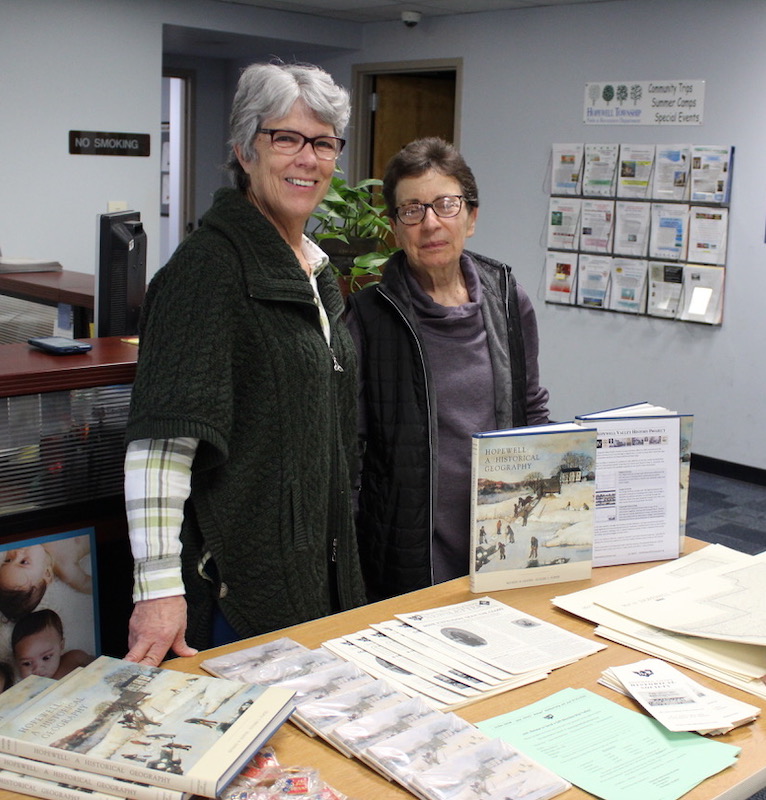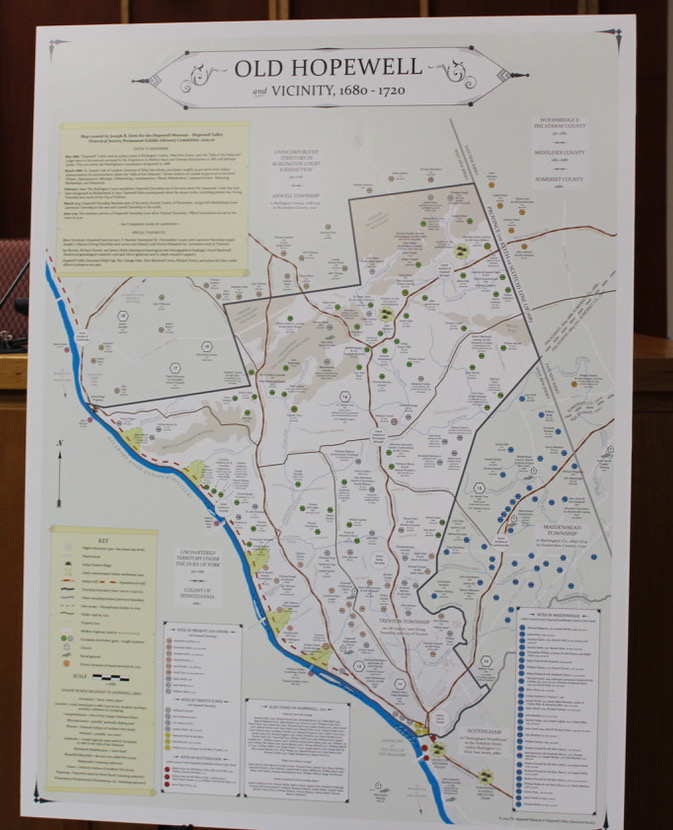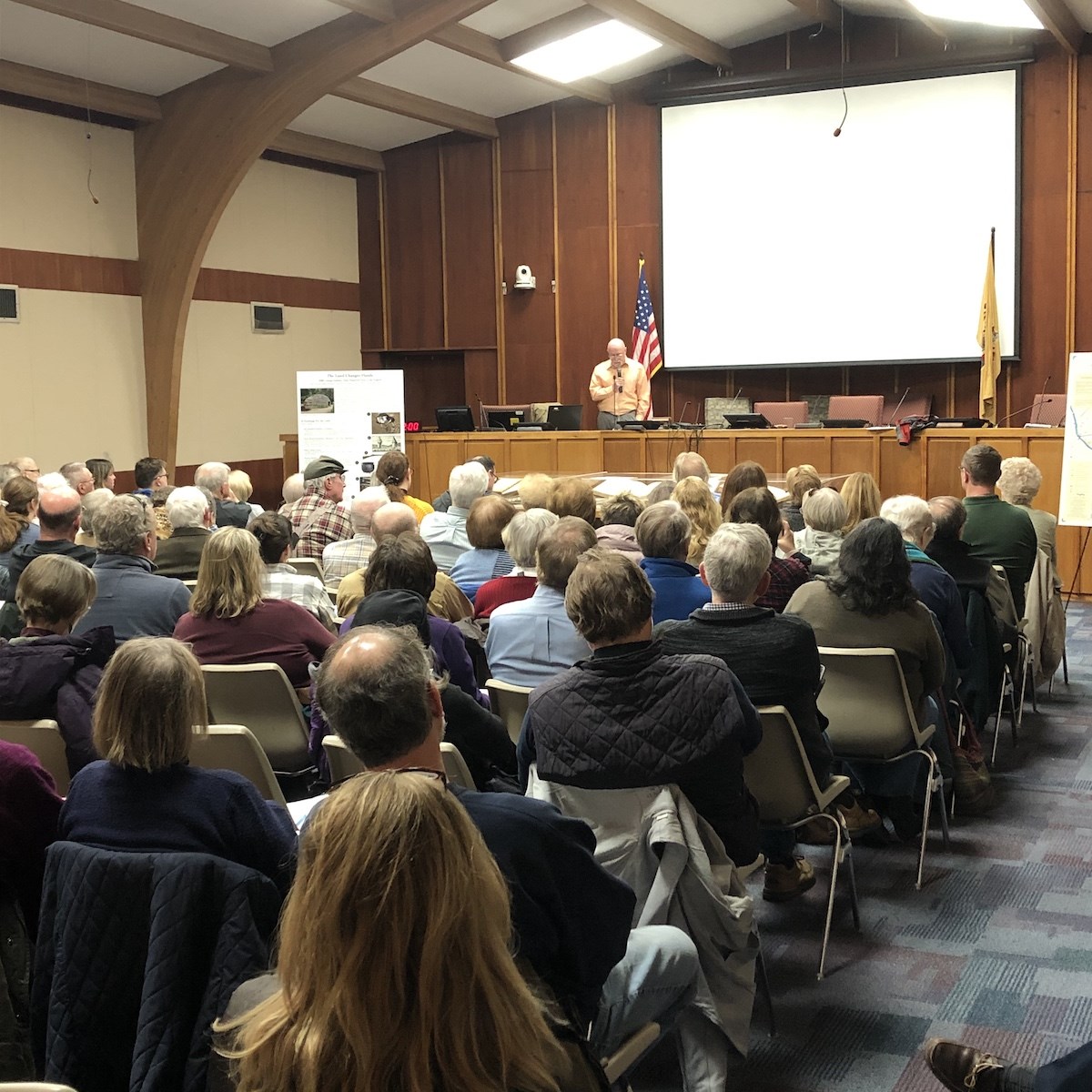Scores of Hopewell residents resisted the balmy breezes of early spring on Sunday and instead entered a closed and windowless room at the Township Municipal Building where they were completely riveted by stories of the past.
The event celebrated Hopewell Township’s 320th birthday (founded on February 20, 1700) and was hosted by The Hopewell Valley Historical Society and The Hopewell Museum. Three speakers presented for nearly three hours to a standing-room-only audience of more than 100 people who did not waver in their attention.

Like any good story, this one starts at the beginning. Archeologist Ian Burrow discussed the Lenape (Delaware) Indians and their influence in this area before and after the colonists came. The first evidence of their inhabitance here goes back 8,000 years, indicated by “La Croix” point pink quartz spear heads that have been found in many locations throughout the Valley.
Burrow said that Native American artifacts have been found at more than 40 locations in Hopewell and Pennington and that they (at the Museum) frequently hear of others. He said one of the reasons the Museum and Historical Society want to get the word out about their activities is so “you can tell us what you’ve got, so we can tell you what it is.”
Burrow also discussed the 1688 deed that the Indians gave to London land speculator Dr. Daniel Coxe, which was lent by the Rutgers University Library for the occasion and was on display for this one-time event. The deed gave Coxe a very large amount of land from Province Line Road to the Delaware River. Burrow said that documents from that era also give insight into what the Indians later thought of the trade.
“You deal hardly with us,” Burrow read from one of the documents, “You claim all the wild animals and you will not let us hunt.” Burrow said there was clearly a clash of cultures in that the English thought they were buying the land in their traditional way, yet the Native Americans thought they were granting access to the land but would still retain the right to hunt on it.

Prior to the talks, children were invited to partake in crafts mostly involving wampum, which were shell beads used by Native Americans as a medium of exchange, later adopted by the Colonists. Burrow further explained the exchange rate of wampum to other goods and how many of those goods were used in the purchase of the land that became Hopewell.
The second speaker was Joseph Klett, president of The Hopewell Museum and executive director of the New Jersey State Archives. Klett spoke about how the land was transferred from Coxe to investors and how it finally came to be known as Hopewell. Originally settled by Quakers, there are several stories of how the name came to be, but Klett thinks the most likely is that it had to do “with a sense of faith and philosophy and endeavoring to do something that you hope God’s providence will shine upon.”

Klett focused mostly on the year 1722 and spoke about the many families who settled here, particularly the Stouts, who were among the first. He told the story of Penelope Stout, from whom all other Stouts are descended, and how she had been kidnapped by Indians and then lived with Indians and had many adventures and numerous children living to an old age.
The final speaker was Richard Hunter, author with Richard Porter of Hopewell’s seminal book “Hopewell: A Historical Geography,” principal of Hunter Research, a Trenton-based historic preservation consulting firm, and president of The Hopewell Valley Historical Society. Hunter spoke about the geography of the area, particularly about maps and how they can help us understand our surroundings.

Specifically, Hunter showed topographical maps illustrating the southwest to northeast ridge — composed of Baldpate Mountain, Pennington Mountain, the Mount Rose ridge and the Sourland mountains — which were formed 190,000 years ago and were igneous rocks exposed over time. To the south, in what he called “the lowlands,” are sedimentary rocks formed more than 200,000 years ago which now are crisscrossed by streams and creeks.
Hunter then described the roads formed by early settlers including the “King’s Highway,” which is now Route 206 and Route 27 and Roger’s Road, which went to Roger Park’s land and is now Route 31. The intersections of those roads then became settlements. He also spoke about the watermills that were a critical component to early development in sawing lumber and processing grain. The only mill that still stands is Somerset Roller Mill on Route 29, which was built in the 1730’s.
Before and after the talks, the public had the opportunity to view the 1688 Indian/Coxe deed, a survey made for Coxe, and a book of minutes from 1700 that documented the founding of the Township. There also was a display of wampum and a map of “Old Hopewell and Vicinity 1680-1720,” a project of the Museum and Historic Society.
The next event sponsored by The Hopewell Valley Historical Society and The Hopewell Museum will be Sunday, March 22, 2020 beginning at 2 pm at the Hopewell Museum. The program will feature Jerry Pevahouse who will talk about the history of local bottling and brewing businesses. This includes the history of local immigration and the contributions of early German and Irish immigrants, then later Italian, Eastern European and Jewish immigrants.




